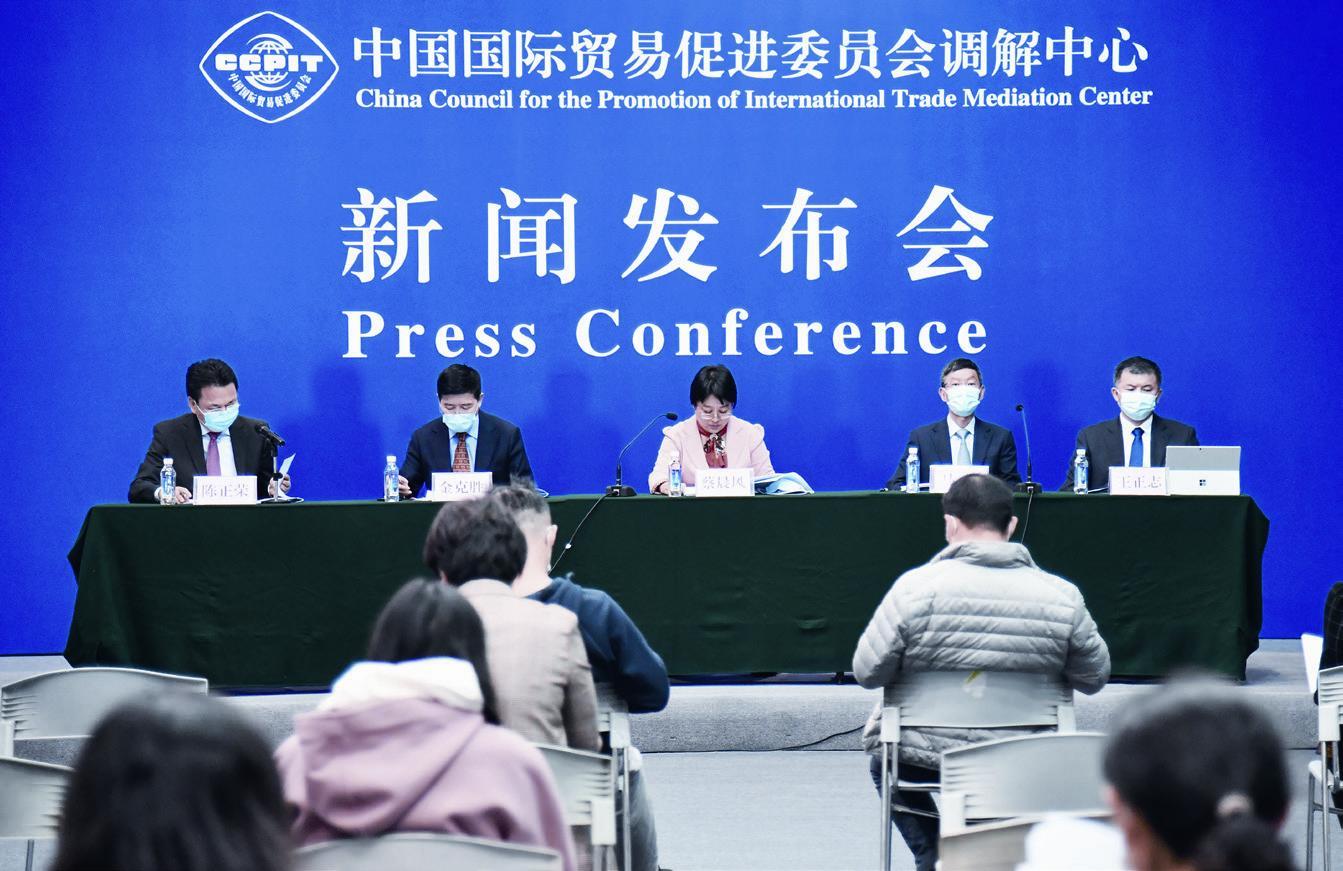Mediation Greatly Facilitates the Development of Intellectual Property Dispute Resolution
By Guo Yan

In recent years, the number of patent applications, trademark applications and copyright regis trations has been on the rise as the whole of societys awareness of intellectual property rights(IPR) has been greatly improved. The number of patent and trademark applications in China has been the highest in the world for many years. At the same time, intellectual property disputes are also increasing year by year.
According to information released by the Supreme Peoples Court, courts nationwide have concluded 2.292 million IPR cases since 2013, with an average annual growth of 24.5%. Intellectual property dispute cases are faced with the situation of “many cases yet a lack of talent”. Facing with a complex situation and an increasing number of cases of intellectual property disputes, all sectors of society are actively exploring the establishment of a diversified mechanism with which to settle intellectual property disputes.
In response to this, the CCPIT Mediation Center recently announced the establishment of the CCPIT Mediation Center Intellectual Property Professional Committee. Cai Chenfeng, Executive Vice Chairman of the CCPIT Mediation Center, said that this committee will play a positive role in helping China build an IPR protection system that supports a world-class business en- vironment, building China into a world-class IPR power with Chinese characteristics.
Bringing together top talents in the field of intellectual property and mediation at home and abroad
The Intellectual Property Committee have announced that they will appoint 10 experts as the initial members, bringing together the top talents in the field of intellectual property and mediation both domestically and abroad. The 10 members have rich backgrounds, including former judges from the Supreme Peoples Court, senior scholars from famous domestic and foreign colleges and universities, well-known intellectual property lawyers both at home and abroad, corporate intellectual property practice workers and mediation theory researchers. Coming from China, the European Union and the U.S., these 10 experts represent an international, professional, high- level team, which may meet the various needs of both domestic and foreign enterprises.
At present, there are many or- ganizations engaged in IPR mediation. What are the advantages of the IPR committee which was set up by the CCPIT Mediation Center? Jin Kesheng, a member of the IPR Committee, said that compared with social institutions engaged in IPR mediation, the IPR Committee of the CCPIT Mediation Center has outstanding advantages. The CCPIT Mediation Center is the earliest foreign-related commercial mediation organization in China, and is thus capable of gathering together domestic and foreign intellectual property experts and providing strong intellectual support for enterprises to solve intellectual property disputes. At the same time, the center has set up 59 sub-centers and more than 90 offices across the country. There are 21 multilateral and bilateral joint mediation mechanisms globally, which make it easier for Chinese and foreign enterprises to reach a consensus when deciding on dispute resolution bodies through consultation.
In addition, the CCPIT Mediation Center has rich experience in IPR case mediation. Last year, the CCPIT Mediation Center handled 3,809 commercial mediation cases. Among these, the number of IPR disputes accounted for 32%, surpassing that of trade in goods for the first time and making it the type of mediation involving the largest number of cases.
Internationally, a large number of intellectual property dispute cases are settled by mediation. Compared with litigation, conciliation can undoubtedly better respond to appeals by the disputing parties for the amicable settlement of disputes, and can also better bridge cultural conflicts and resolve multilateral disputes.
Wang Zhengzhi, a member of the Intellectual Property Committee, believes that mediation, as a nonadversarial dispute resolution method, focuses on the commercial interests of the parties concerned, and maintains or develops the potential commercial relationship between the parties. It has the characteristics of voluntary choices, confidential information and mediation being performed at any time. Once a consensus is reached, a settlement agreement can be signed. Settlement agreements reached through mediation have a performance rate of more than 90%, which is of great value for solving the long-standing problems of intellectual property disputes being time-consuming, affecting cooperative relationships and being difficult to execute.
Not long ago, the State Intellectual Property Office and the Ministry of Justice jointly issued the Opinions on Strengthening the Mediation of Intellectual Property Disputes. Wang Zhengzhi said that this fully reflects the state administrative authoritieshigh level of support for solving intellectual property disputes through mediation, and advocates for commercial mediation by using marketoriented approaches, which will greatly promote the development of commercial mediation of intellectual property.
Chinas first commercial mediation rules for resolving foreign-related intellectual property disputes are released
At present, the State has not yet formulated a special commercial mediation law, and the construction of a diversified dispute resolution mechanism urgently needs to be strengthened.
As the Chinese saying goes,“without rules, nothing can be accomplished”. Many enterprises have expressed the hope that the CCPITs Mediation Center will issue mediation rules on intellectual property disputes as soon as possible. To this end, after scientific drafting, full argumentation and repeated deliberation, a new set of rules (hereinafter referred to as the Rules for Mediation of Intellectual Property Disputes) were promulgated and formally implemented by the China Council for the Promotion of International Trade/Mediation Center of the China Chamber of International Commerce on November 1st, 2021. This is the first set of commercial mediation rules for solving foreignrelated intellectual property disputes in China, which is of great significance to improving the construction of the intellectual property dispute settlement mechanism and promoting the development of commercial mediation, and is an important achievement in the field of commercial dispute settlement in China.
The Rules for Mediation of Intellectual Property Disputes fully reflect many characteristics of commercial mediation, including autonomy, confidentiality, convenience, a friendly process, economic efficiency and seeking common interests. With the parties as the center, the Rules have realized the balance between respecting each partys autonomy and standard and fair mediation procedures.
The technical content was added to the mediation rules for the first time. For instance, relevant experts or authorities can be employed to provide technical support, evaluation, auditing, verification, testing or consulting regarding relevant technical content, the use of technology and any losses caused. This may realize the concept of professional staff providing professional services and allowing the resolution of disputes to be fair and persuasive.
In addition, the Mediation Cen- ter has established a joint multilateral and bilateral mediation mechanism with 21 dispute resolution institutions across the world, allowing them to conduct joint mediation with these institutions, fully reflecting the professionalism and international nature of the CCPIT as the earliest professional foreign-related commercial mediation institution in China.Nowadays, as enterprises are faced with an increasing number of foreign intellectual property disputes, the Mediation Center provides enterprises with a new approach for solving intellectual property disputes.
According to the 2021 Global Innovation Index Report released by the World Intellectual Property Organization (WIPO) in September 2021, China ranked 12th, up 23 places from 35th in 2013. In recent years, China has achieved remarkable progress in the development of intellectual property rights, and the governance capacity and the level of intellectual property protection are constantly being improved, which also lays a favorable foundation for intellectual property mediation.
Intellectual property disputes show the trend of internationalization
The Central Committee of the Communist Party of China and the State Council recently issued the Outline for Building a Strong Intellectual Property Rights Country(2021-2035), which calls for the establishment and improvement of IPR arbitration, mediation, notarization, authentication and assistance systems, and the strengthening of the relevant systems. It is hoped that this will allow for exploration of the judicial confirmation system of administrative mediation agreement for in- tellectual property disputes between various parties.
In China, with the increasing demand for intellectual property dispute resolution, more and more forces are participating in dispute governance. Jin Kesheng, a member of the Intellectual Property Committee, said that “at present, Chinas IPR dispute resolution mechanism has created a pattern of diversified subjects, rules and methods, as well as coexistence between judicial relief, administrative relief and civil autonomy. Due to the complexity of IPR dispute resolution and the rapid development of science and technology, new things and new circumstances are constantly emerging. How to combine the limited judicial and administrative forces with civil forces is an important topic which must be addressed to improve the efficiency of IPR dispute resolution.”
As for the international community, cross-border civil and commercial activities based on intellectual property rights have become more frequent. The development of technologies such as communications, networks, logistics and transportation has facilitated cross-border activities. The obvious trend towards the internationalization of intellectual property disputes makes international mediation an option for resolving cross-border intellectual property disputes, which provides a consensual basis for parties in mediation to seek common ground and also reduces transaction costs.
Jin Kesheng also reiterated that mediation has the inherent advantage of resolving international intellectual property disputes. The mediation system provides a whole set system design for dispute settlement procedures and guides parties towards a settlement result. In practice, a large number of intellectual property dispute cases are settled by mediation. For example, in the United States, more than half of the cases of intellectual property litigation are settled by conciliation. Compared with litigation, mediation is undoubtedly a better response to the parties appeal for the amicable settlement of disputes, as well as a better way to bridge cultural conflicts and resolve multilateral disputes.
In recent years, the CCPIT Mediation Center and its sub-centers have handled a large amount of IPR mediation work. Taking the Dongguan Mediation Center of CCPIT as an example, the center accepted 353 IPR cases from 2019 to 2021, mainly involving copyright and trademark infringement disputes. 134 of the cases were foreign-related, with all of the parties involved in these cases applying for mediation to the Mediation Center on their own initiative. It is clear that intellectual property mediation is receiving more and more recognition.
Ma Hao, Chairman of the Intellectual Property Committee, said that in the future, the Intellectual Property Committee of the CCPIT Mediation Center will give full play to its professional advantages of wellconducted research, consultation and case handling to provide satisfactory services to all parties concerned. The Committee will continue to take on domestic and foreign experts in various fields, constantly improve its ability to deal with various types of cases and fully meet the different needs of domestic and foreign commercial parties. In addition, it will strengthen friendly exchanges and cooperation with mediation institutions around the world to further promote the application of mediation in the field of intellectual property rights.

